#railway operating division
Explore tagged Tumblr posts
Text
So recently a while ago I started drawing up a list of the War Department Light Railway's locos, and because I'm me I'm having a crack at the full (or close as) ROD roster
Ohdeargodthiswasamistake
#real train stuff#railway operating division#war department light railways#wdlr#trench railways#help me#i drafted this back in December#and just came back round to the sheet#mistakes were indeed made
0 notes
Text
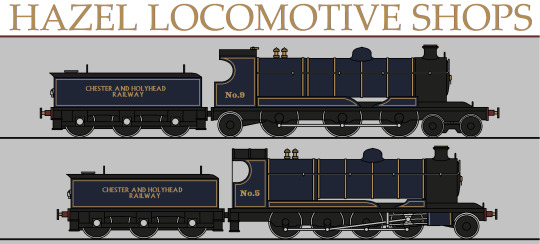
Tonight's file is the ROD 2-8-0. One f my favorite engines.
17 notes
·
View notes
Text
Freight Train Accident Damages Foot Over Bridge at Sonua Station
Operations on main lines disrupted as damaged foot over bridge is removed. A freight train with an open door collided with a foot over bridge pillar, causing damage at Sonua station. JAMSHEDPUR – In a significant incident, a freight train passing through Sonua station in the Chakradharpur Railway Division caused substantial damage to a foot over bridge after its open door struck the bridge…
#जनजीवन#Chakradharpur rail traffic#Chakradharpur Railway Division#foot over bridge damage#freight train collision#Indian Railways updates#Life#passenger advisories#rail safety measures#railway bridge repairs#Sonua Station accident#train operations disrupted
0 notes
Text

• Stanisław Sosabowski
Stanisław Franciszek Sosabowski was a Polish general in World War II. He fought in the Polish Campaign of 1939 and at the Battle of Arnhem (Netherlands), as a part of Operation Market Garden, in 1944 as commander of the Polish 1st Independent Parachute Brigade.
Stanisław Sosabowski was born on May 8th, 1892 in Stanislau, in what was then Austria-Hungary and is now Ivano-Frankivsk in western Ukraine. His father was a railway worker. Sosabowski graduated from a local gymnasium and in 1910 he was accepted as a student of the faculty of economy of the Jagiellonian University in Kraków. However, the death of his father and the poor financial situation of his family forced him to abandon his studies and return to Stanislau. There he became a member of Drużyny Strzeleckie, a semi-clandestine Polish national paramilitary organisation. He was soon promoted to the head of all Polish Scouting groups in the area. In 1913, Sosabowski was drafted into the Austro-Hungarian Army. After training, he was promoted to the rank of corporal, serving in the 58th Infantry Regiment. After the outbreak of World War I he fought with his unit against the Imperial Russian Army in the battles of Rzeszów, Dukla Pass and Gorlice. For his bravery, he was awarded several medals and promoted to first lieutenant. In 1915, he was badly wounded in action and withdrawn from the front. In November 1918, after Poland regained its independence Sosabowski volunteered for the newly formed Polish Army, but his wounds were still not healed and he was rejected as a front-line officer. Instead, he became a staff officer in the Ministry of War Affairs in Warsaw.
After the Polish-Soviet War Sosabowski was promoted to major and in 1922 he started his studies at the Higher Military School in Warsaw. After he finished his studies he was assigned to the Polish General Staff. Promoted to lieutenant colonel, in 1928 he was finally assigned to a front-line unit, the 75th Infantry Regiment, as commanding officer of a battalion. The following year he was assigned to the 3rd Podhale Rifles Regiment as its deputy commander. From 1930 he was also a professor of logistics at his alma mater. In 1937 Sosabowski was promoted to colonel and became the commanding officer of the 9th Polish Legions Infantry Regiment stationed in Zamość. In January 1939 he became the commander of the prestigious Warsaw-based 21st Infantry Regiment. According to the Polish mobilisation scheme, Sosabowski's regiment was attached to the 8th Infantry Division. Shortly before the German invasion of Poland started his unit was moved from its garrison in the Warsaw Citadel to the area of Ciechanów, where it was planned as a strategic reserve of the Modlin Army. On September 2nd, the division was moved towards Mława and in the early morning of the following day it entered combat in the Battle of Mława. Although the 21st Regiment managed to capture Przasnysz and its secondary objectives, the rest of the division was surrounded by the Wehrmacht and destroyed. After that Sosabowski ordered his troops to retreat towards Warsaw. Sosabowski was ordered to man the Grochów and the Kamionek defensive area and defend Praga, the eastern borough of Warsaw, against the German 10th Infantry Division. During the Siege of Warsaw the forces of Sosabowski were outmanned and outgunned, but managed to hold all their objectives. When the general assault on Praga started on September 16th, the 21st Infantry Regiment managed to repel the attacks of German 23rd Infantry Regiment and then successfully counter-attacked and destroyed the enemy unit. After this success, Sosabowski was assigned to command all Polish troops fighting in the area of Grochów. Despite constant bombardment and German attacks repeated every day, Sosabowski managed to hold his objectives at relatively low cost in manpower. On September 26th, 1939, the forces led by Sosabowski bloodily repelled the last German attack, but two days later Warsaw capitulated.
Following the Polish surrender, Sosabowski was made a prisoner of war and interned at a camp near Żyrardów. However, he escaped and remained in Warsaw under a false name, where he joined the Polish resistance. He was ordered to leave Poland and reached France to report on the situation in occupied Poland. After arriving in Paris, The Polish government in exile assigned him to the Polish 4th Infantry Division as the commanding officer. Initially, the French authorities were very reluctant to hand over the badly needed equipment and armament for the Polish unit. Sosabowski's soldiers had to train with pre-World War I weapons. In April 1940, the division was moved to a training camp in Parthenay and was finally handed the weapons awaited since January, but it was already too late to organise the division. Out of more than 11,000 soldiers, only 3,150 were given arms. By June 1940, Sosabowski with approximately 6,000 Polish soldiers arrived at La Pallice, whence they were evacuated to Great Britain. Upon his arrival in London, Sosabowski turned up at the Polish General Staff and was assigned to 4th Rifles Brigade that was to become a core of the future 4th Infantry Division. The unit was to be composed mainly of Polish Canadians, but it soon became apparent that there were not enough young Poles in Canada from which to create a division. Then, Sosabowski decided to transform his brigade into a Parachute Brigade, the first such unit in the Polish Army. The volunteers came from all the formations of the Polish Army. In Largo House in Fife, a training camp was built and the parachute training was started. Sosabowski himself passed the training and, at 49 years of age, made his first parachute jump. In October 1942 the Brigade was ready for combat and was named the 1st Independent Parachute Brigade. Since the Polish General Staff planned to use the Brigade to assist a national uprising in Poland, the soldiers of the 1st Polish Para were to be the first element of the Polish Army in Exile to reach their homeland. Hence the unofficial motto of the unit: by the shortest road (najkrótszą drogą).
In September 1943, Lieutenant-General Frederick Browning proposed that Sosabowski reform his unit into a division and fill the remaining posts with British troops. Sosabowski himself would be assigned to the newly formed division and promoted to general. However, Sosabowski refused. Nevertheless, on June 15th, 1944 he was promoted to Brigadier General. In early August 1944, news of the Warsaw Uprising arrived in Great Britain. The Brigade was ready to be dropped by parachute into Warsaw to aid their comrades from the underground Polish Home Army, who were fighting a desperate battle against overwhelming odds. However, the distance was too great for the transport aircraft to make a round trip and access to Soviet airfields was denied. The morale of the Polish troops suffered badly and many of the units verged on mutiny. The British staff threatened its Polish counterpart with disarmament of the Brigade, but Sosabowski retained control of his unit. Finally, Polish Commander in Chief Kazimierz Sosnkowski put the Brigade under British command, and the plan to send it to Warsaw was abandoned.
During the planning for Operation Market Garden, Sosabowski expressed serious concerns regarding the feasibility of the mission. Among Sosabowski's concerns were the poorly conceived drop zones at Arnhem, the long distances between the landing zones and Arnhem Bridge and that the area would contain a greater German presence than British intelligence believed. Despite Sosabowski's concerns and warnings from the Dutch Resistance that two SS Panzer Divisions were in the operations area, Market Garden proceeded as planned. The Polish 1st Independent Parachute Brigade was among the Allied forces taking part in Market Garden. Due to a shortage of transport aircraft, the brigade was split into several parts before being dropped into the battle. A small part of the brigade with Sosabowski was parachuted near Driel on September 19th, but the rest of the brigade arrived only on September 21st at the distant town of Grave, falling directly on the waiting guns of the Germans camped in the area. The brigade's artillery was dropped with the British 1st Airborne Division. Three times Sosabowski attempted to cross the Rhine to come to the assistance of the surrounded 1st Airborne Division. Unfortunately, the ferry they hoped to use had been sunk and the Poles attempting to cross the river in small rubber boats came under heavy fire. Even so, at least 200 men made it across the river and reinforced the embattled British paratroopers. Despite the difficult situation, at a staff meeting on September 24th, Sosabowski suggested that the battle could still be won. He proposed that the combined forces of XXX Corps, under Lieutenant-General Brian Horrocks, and the Polish 1st Independent Parachute Brigade should start an all-out assault on the German positions and try to break through the Rhine. This plan was not accepted, and during the last phase of the battle, on 25th and 26th of September, Sosabowski led his men southwards, shielding the retreat of the remnants of the 1st Airborne Division. Casualties among the Polish units were high, approaching 40%. After the battle, on October 5th, 1944, Sosabowski received a letter from Field Marshal Bernard Montgomery, commander of the Anglo-Canadian 21st Army Group, describing the Polish soldiers as having fought bravely and offering awards to ten of his soldiers. However, on October 14th, 1944, Montgomery wrote another letter, this time to the British commanders, in which he scapegoated Sosabowski for the failure of Market Garden. Sosabowski was accused of criticizing Montgomery, and the Polish General Staff was forced to remove him as the commanding officer of his brigade on December 27th, 1944.
Sosabowski was eventually made the commander of rearguard troops and was demobilized in July 1948. Shortly after the war Sosabowski succeeded in evacuating his wife and only son from Poland. Like many other Polish wartime officers and soldiers who were unable to return to Communist Poland on pain of repercussions including death or disappearance, he settled in West London. He found a job as a factory worker at the CAV Electrics assembly plant in Acton.He died in London on September 25th, 1967. In 1969, Sosabowski's remains were returned to Poland, where he was reinterred at Powązki Military Cemetery in Warsaw. In The Hague, on May 31st, 2006, Queen Beatrix of the Netherlands awarded the Military Order of William to the Polish 1st Independent Parachute Brigade. The brigade's commander, Sosabowski, was posthumously awarded the "Bronze Lion". On June 1st, a ceremony was held at Driel, the town where the Polish 1st Independent Parachute Brigade fought. Among the speakers at the ceremony were the mayor of Overbetuwe, as well as Sosabowski's grandson and great-grandson. Sosabowski was portrayed by Gene Hackman in the 1977 war film A Bridge Too Far. In the summer of 2012 1st Airborne Major Tony Hibbert made a video appeal for Sosabowski to be pardoned and honoured.
#second world war#world war 2#world war ii#wwii#military history#airborne history#airborne#polish history#poland#a bridge too far#unsung heroes#market garden#polish airborne
64 notes
·
View notes
Text
An updated (January 9, 2025 9:04pm pst) list of WW2 movies and TV shows in chronological order
thought out WW2 -(Imitation Game 2014) -(The Book Thief 2013) -(The Zookeeper’s Wife 2017) -(The Pianist 2002)
1937
October 26, 1937 Defence of Sihang Warehouse (The Eight Hundred 2020)
December 13, 1937 Nanjing Massacre - (John Rabe 2009) - (The Flowers of War 2011)
1938
Fall of 1938 (Munich – The Edge of War 2022)
1939
Summer 1939 (Six Minutes to Midnight 2020)
September 3, 1939 King George VI first wartime speech (King’s Speech 2010)
September 17, 1939, Soviet Union Invitation of Poland (The Way Back 2010)
November 30, 1939 Soviet Union invades Finland (The Winter War 1989)
1940
April 9, 1940 Operation Weserübung -(April 9th [movie] 2015) -(King’s Choice 2016) -(Narvik 2022) -(War Sailors 2023)
April 27, 1940 (Into the White 2011)
June 4, 1940 -Churchill gives “We Shall Fight on the Beaches” speech (Darkest Hour 2017) -Dunkirk Evaluation (Dunkirk 2017)
July 10-October 31, 1940 Battle of Britain (Battle of Britain 1969)
1941
May 1941 (Call to Spy 2019)
June 22, 1941 Operation Barbarossa -(Fortress of War [The Brest Fortres 2010) -(Defiance 2008)
September 8, 1941, Siege of Leningrad begins. -(Battle of Leningrad [Saving Leningrad] 2019) -(Leningrad 2009)
October 1941 Battle of Moscow (The Last Frontier [The Final Stand] 2020)
October 1941 Battle of Sevastopol (Battle for Sevastopol 2015)
December 7, 1941, the Empire of Japan attacks Pearl Harbor (Tora! Tora! Tora! 1970)
December 8, 1941 Japan invades Shanghai International Settlement (Empire of the Sun 1987)
1942
January 20, 1942, Wannsee Conference (Conspiracy 2001)
February 1942 Battle of the Atlantic (Greyhound 2020)
February 1942 (The Railway Man 2013)
February 19, 1942, Bombing of Darwin (Australia 2008)
Spring 1942 (U-571 2000)
April 18, 1942 The Doolittle Raid (In Harm’s Way 2018)
June 4, 1942 Battle of Midway (Midway 2019)
1942 Summer Occupation of Jersey Island (Another Mother’s Son 2017 Prime)
July, 10 1942 Easy Company Trains in Camp Tocca (Band of Brothers 01x10 Currahee 2001)
July 21, 1942, Kokoda Track Campaign (Kokoda: 39th Battalion 2006)
August 7, 1942, 1st Marine Division land on Guadalcanal (The Pacific Ep. 1 Guadalcanal/Leckie 2010)
August 19, 1942, Dieppe Raid (Dieppe 1993)
August 23, 1942 Battle of Stalingrad begins (Stalingrad 1993)
September 1942 Formation of Troop 30 (Age of Heroes 2011)
September 18, 1942, 7th Marines Land on Guadalcanal (The Pacific Ep. 2 Basilone 2010)
Autumn of 1942 Battle of the Atlantic (Das Boot 1981)
October 18, 1942, Operation Grouse (Heavy Water War Ep. 2 2015)
November 8, 1942, Operation Torch (The Big Red One 1980)
November 10-17 1942 Vasily Zaytsev kills 225 German Soldiers during the Battle of Stalingrad (Enemy at the Gates 2001)
December 1942 The 1st Marine Division on Guadalcanal is relieved (The Pacific Ep. 3 Melbourne 2010)
December 15, 1942, Battle of Mount Austen (Thin Red Line 1998)
1943
March 13-14 1943, liquidation of the Kraków Ghetto -(Schindler’s List 1993)
April 17, 1943 Operation Mincemeat (Operation Mincemeat 2021)
April 19, 1943, beginning of the Warsaw Uprising (Uprising 2001)
May 4, 1943, Final Mission of The Memphis Bell (Memphis Bell 1990)
May 15, 1943, Salamo Arouch and his family arrive in Auschwitz Concentration Camp (Triumph of the Spirit 1989)
May 27, 1943 Louis Zamperini plane crashes on a search and rescue mission (Unbroken 2014)
May 30, 1943 first All-American Girls Professional Baseball League game played (A League of Their Own 1992)
June 25, 1943, 100th Bomb Group flew its first 8th Air Force combat mission (Master of the Air: Part One 2024)
July 1943 -(The Tuskegee Airmen 1995) -(The Liberator Ep. 1 2020) -(Heavy Water War Ep. 5 2015)
July 16, 1943, The 100th Bomb Group bombed U-Boats in Tronbhdim (Masters of the Air: Part Two 2024)
August 17, 1943 the 4th Bomb Wing of the 100th Bomb Group bombed Regenberg (Masters of the Air: Part Three 2024)
September 16, 1943, William Quinn and Charles Bailey leave Belgium (Masters of the Air: Part Four 2024)
September 18, 1943 John ‘Bucky’ Egan returns from leave to join the mission to bomb Munster (Master of the Air: Part Five 2024
October 14, 1943, John ‘Bucky’ Egan interrogated at Dulag Lut, Frankfurt Germany (Masters of the Air: Part Six 2024)
December 26, 1943, 1st Marine Division lands on Cape Gloucester (The Pacific Ep. 4 Gloucester/Pavuvu/Banika 2010)
1944
January 22, 1944, Battle of Anzio -(The Liberator Ep. 2 2020) -(Red Tails 2012) -(Anzio 1968)
February 20, 1944, Hydro Ferry bombing (Heavy Water War Ep. 6 2015)
March 7, 1944, Stalag Luft III Sagan, Germany, Germans find the concealed radio Bucky was using to learn news of the War (Master of the Air: Part Seven 2024)
March 24/25, 1944 Allied Mass Escape of Stalag Luft III (The Great Escape 1963)
June 1944 (Cross of Iron 1977)
June 6, 1944, 00:48 & 01:40 First airborne troops begin to land on Normandy (Band of Brothers 02x10 Day of Days 2001)
June 6, 1944, 06:30 D-Day landings -(Storming Juno 2010)
-(Saving Private Ryan 1998)
June 10, 1944, Easy Company Takes Carentan (Band of Brothers 03x10 Carentan 2001)
June 15-July 9, 1944 Battle of Saipan
-(Windtalkers 2002)
-(Oba: The Last Samurai 2011)
July, 1944 The Monuments Men land in Normandy (The Monuments Men 2014)
July 20, 1944 Operation Valkyrie (Valkyrie 2008)
August 12, 1944, The 332nd Fighter Group attack Radar stations in Southern France (Masters of the Air: Part Eight 2024)
September 15, 1944, U.S. Marines landed on Peleliu at 08:32 (the Pacific Ep. 5 2010)
September 16, 1944, U.S Marines take Peleliu Airfield (the Pacific Ep. 5 2010)
September 17, 1944, Operation Market Garden
-(Band of Brothers 04x10 Replacements 2001)
-(A Bridge Too Far 1977)
October 2, 1944 Battle of Scheldt (Forgotten Battle 2021)
October 12, 1944, Battle of Peleliu, Assault on Bloody Nose Ridge (the Pacific Ep. 7 Peleliu Hills 2010)
October 13, 1944, Rovaniemi public buildings were destroyed (Sisu 2022)
October 14, 1944, Erwin Rommel is arrested (Rommel 2012 Prime)
October 22/23, 1944, 2100 – 0200 Operation Pegasus (Band of Brothers 05x10 Crossroads 2001)
November 1944 middle of the Battle of Hürtgen Forest (When Trumpets Fade 1998)
December 16, 1944, Battle of the Bulge (Band of Brothers 06x10 Bastogne 2001)
December 1944 (Hart’s War 2002)
1945
January 2, 1945 (The Liberator Ep 3 2020)
January 10, 1945 (Attack Force Z)
January 13, 1945, Battle of Foy (Band of Brothers 07x10 The Breaking Point 2001)
January 30, 1945 The Raid at Cabanatuan (The Great Raid 2002)
February 14, 1945, David Webb rejoins the 506th in Haguenau (Band of Brothers 08x10 The Last Patrol 2001)
February 19, 1945, Battle of Iwo Jima starts. - (Letters from Iwo Jima 2006) - (The Pacific Ep. 8 Iwo Jima 2010) - (Flags of our Fathers 2006)
February 15, 1945, 6888 Battalion was inspected and marched in review before Major General John C. H. Lee (Six Triple Eight 2024)
March 7, 1945, Battle of Remagen (The Bridge at Remagen 1969)
March 21, 1945, Operation Carthage (The Bombardment 2021)
April, 1945 (Fury 2014)
April 5, 1945, 506th Finds abandoned Concentration Camp (Band of Brothers 09x10 Why We Fight 2001)
April 17, 1945 Lee Miller arrives at Concentration Camp Buchenwald (Lee 2023)
April 26, 1945, near the end of the war in Europe (A Woman in Berlin 2008)
April 29, 1945, 45th Infantry Division liberated Dachau Concentration camp (The Liberator Ep. 4 2020)
May 2, 1945, Fall of Berlin -(Downfall 2004) -(Jojo Rabbit 2019)
May 1945 Battle of Okinawa -(Hacksaw Ridge 2016) -(The Pacific Ep. 9 Okinawa 2010)
May 7, 1945, Germany Surrenders V-E Day - (Master of the Air: Part Nine 2024) - (Band of Brothers 10x10 Points 2001)
July 30, 1945, USS Indianapolis sank. (USS Indianapolis 2016)
August 15, 1945, The Empire of Japan surrenders end of the War. -(Oppenheimer 2023) -(The Pacific Part Ten: Home 2010)
September 11, 1945 US Military search and Arrest Japanese Leaders for war crimes (Emperor 2012)
1946 April 29, 1946 Tokyo War Crimes Tribunal (Tokyo Trial 2016)
78 notes
·
View notes
Text
The Queensland C17 class

Queensland Railways C17 Class No.967 in the Historical Gympie Station Platform. [01/08/2020) : r/queensland
The Queensland Railways C17 class is a class of 4-8-0 steam locomotives operated by the Queensland Railways (QR). The class was designed to be an improvement of the C16 class. As per QR's classification system any class with a C had 4 driving axles on the locomotive. 227 locomotives were built from 1920 when the first engine No. 15 until 1953 when No. 1000 was the last delivered. The design of the last inspired Commonwealth Railways to have their NM class built with some modification.

Queensland Rail Heritage 1951 steam train C17 class number… | Flickr
The class hauled mail trains on the lines that could not accommodate the much heavier B18¼ class. They also hauled passenger trains, goods, mixed trains and branch line work. The class was the heaviest locomotives that could operate north of MacKay until 1948. The class was also responsible for hauling the Inlander, Midlander and the Westlander trains for parts of the journey up until the introduction of diesel electric locomotives.

Australian 1951 built C17 class locomotive number 974 leav… | Flickr
25 where preserved and 202 where scrapped of the class. The Mary Valley Rattler a Heritage Railway has 8 of the class. No. 1000 of the class is at Queensland Rail Heritage Division and is stored at the Workshops Rail Museum in Ipswich, Queensland.
videos of the class running:
Queensland Rail Heritage - Kingaroy Branch C17 974 - 1997
C17 No.974 Goes To Yandina
C17 974 - Cab Ride Clifton to Toowoomba - 24/09/2016
#australia#steam locomotive#australian steam engines#steam train#steam engine#queensland#Queensland Railways
29 notes
·
View notes
Text

Northern Explorer Train, Auckland, New Zealand: Journey from Auckland to Wellington... The Northern Explorer is a long-distance passenger train operated by the Great Journeys New Zealand division of KiwiRail between Auckland and Wellington in the North Island of New Zealand, along the North Island Main Trunk (NIMT). Three services operate per week in each direction between Auckland's The Strand Station and Wellington railway station. Wikipedia
#Northern Explorer Train#Auckland#Journey from Auckland to Wellington#North Island#New Zealand#oceania
85 notes
·
View notes
Text
Train Spotlight: BR Class 000

In service: 1975-present
Manufacturer: British Rail Research Division
Capacity: arbitrary
Operators: Network Rail, British Rail (former)
Train length: arbitrary, usually 10-100m
Width: around 1.5-3m
Height: around 3-4m
Maximum speed: arbitrary, but typically 55m/s (200km/hr)
Mass: arbitrary, ranges from 10-100 tonnes
Engine type: electric, diesel, or gas turbine
Power output: around 1000kW (electric version can be arbitrarily powerful)
Acceleration: around 1m/s^2
Electric systems: 25kV AC overhead and 750V DC third rail
The British Rail Class 000 is an electric/diesel/gas turbine multiple unit, designed by the British Rail Research Division. With its distinctive boxy shape, it can easily be recognized in physics problems across Britain. The train also comes in a locomotive variant, although those are considered to be Class 97s. Class 000s should not be confused with the Pennsylvania Railroad's U1 locomotive, a 0-0-0 steam locomotive used for similar purposes, including problems such as "If a train leaves Boston at 9:45 am, travelling at 100mph, and another train leaves Washington at 11:00am, travelling at 80mph, when do the two trains meet?"
The Class 000 was created so BR could solve physical problems involving trains without potentially damaging existing rolling stock or endangering the lives of staff and passengers. In this regard, it has performed well, as despite countless collisions, derailments, and other incidents, it has a perfect safety record, with no deaths or serious injuries caused.
Following the privatization of BR and the end of its research division, many Class 000's were left to rust on sidings in secondary school science textbooks, but recently Network Rail has brought them back into service to help explain how the railway works. With the advent of renationalization under Great British Railways, there is hope that the Class 000 could once again be used to innovate in the field of rail.
12 notes
·
View notes
Text
Suddenly had the thought that Edward and Skarloey are old friends because they were both recruited as counterintelligence operatives for some division of British intelligence during WWII. Perhaps part of the reason why Edward is so gosh-darn perceptive is because during WWII, he was partly responsible for monitoring activities at Brendam Bay/the docks and ensuring no foreign spies made it to Sodor unreported. Skarloey, on the other hand, did similar work and kept an eye on the railway, but ESPECIALLY Kirk Ronan, with the slate shipments. They met up at Crovan's Gate whenever Edward took a special train or needed repairs (which was often, given his age and class), allowing for smooth exchange of information. And ofc, engines are great ways to ensure your communications get from place to place in a timely fashion.
Besides, who would ever think that two ancient engines would be employed as spies? They're just engines; what do they know?
16 notes
·
View notes
Text
The Iraqi government has shortlisted 11 shipping firms to compete for Baghdad’s Grand Faw Port project, the director general of the country’s General Company for Ports said on 12 November.
The selected firms include China Merchants Port Group Co., Taiwanese container shipping firm Evergreen, French shipping conglomerate CMA CGM, Mediterranean Shipping Company (MSC), Indian firm Adani, and UAE-based ABM Global Shipping LLC, among others.
Baghdad will select a winning company at the very start of next year, Director of the General Company for Ports Farhan al-Fartousi told Reuters.
“Faw Port is expected to operate in maximum capacity to receive 3.5 million containers in 2028,” he said. “The Grand Faw Port will be a pivotal hub for transforming global transport trade towards Europe via Turkey,” Fartousi added.
Iraq launched the Development Road Project in May 2023, seeking to link the Grand Faw Port in the oil-rich south to Turkiye via railways and roads. The objective is to transform the war-torn country into a major regional transportation hub.
Baghdad plans to connect the Faw Port in the Basra governorate to Faysh Khabur on the Iraqi–Turkish border via the Development Road. The land corridor stretches 1,200 kilometers from the Persian Gulf to the Mediterranean Sea. The project is worth around $17 billion.
Turkiye’s transport minister announced��earlier this year that projects encompassing the Development Road Project are “nearing completion.”
“While the Dry Canal and Grand Faw Port offer opportunities for Iraq to boost its geopolitical position, internal challenges such as mismanagement and political division, and external challenges such as investment competition between China and the US, present obstacles to success,” The Cradle columnist Mohammad Hassan Sweidan explained in January.
5 notes
·
View notes
Text
German street car lights
I researched this for my own reasons (that I may post about later), but I decided to put it here so I don't forget it.
Headlights. Taillights. We know how they work, we've all seen cars before. White in front, red in back, orange turn indicators, braking makes red extra bright. But for streetcars it's not always quite that simple, which makes modelling a challenge.
First of all, front: All cars and trucks and indeed all modern streetcars have two main headlights, side by side, roughly at the outer edges of the vehicle. Modern german streetcars actually have a third headlight up on top, legally required but barely visible. In this picture of a TW 6000 from Hanover (don't worry, the track curves away there, I was well clear of where the train could travel), it's the tiny little lamp above the destination display.
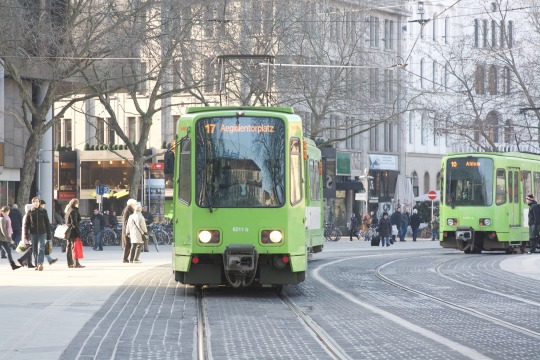
The idea is to make streetcars like big trains, which (in Germany, and for new trains in all of Europe) have three white lights in an upside-down V configuration in front (exceptions apply). The third light is supposed to make it clear that the thing hurtling towards you is a train. I'm not sure how well it works in this case.
But that is a fairly recent thing. For a really long time, well into the 1970s, the standard was a single central headlight. Consider this train in Vienna (note the pride flag, not relevant, just for fun):
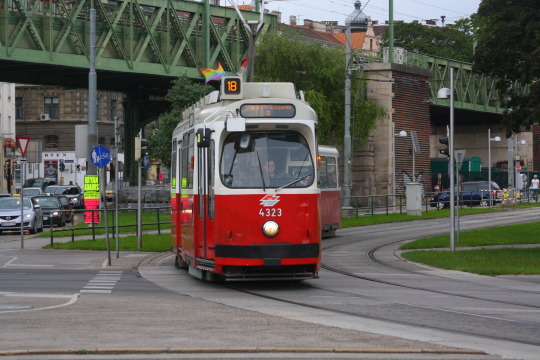
This is a type E₂ train, first introduced in 1978, still in use today (though probably not for much longer, if you're in Vienna and you see one of them, take a picture).
Now, Austria isn't Germany, but the standards between the two countries weren't that wildly different. As far as I can tell there was no one time when dual headlights were introduced; some cities bought trains with two headlights, some with one, often at the same time. The E₂ here was sold with single headlights to Vienna, Braunschweig, Augsburg, Duisburg and a couple of others, but also with dual headlights to Düsseldorf.
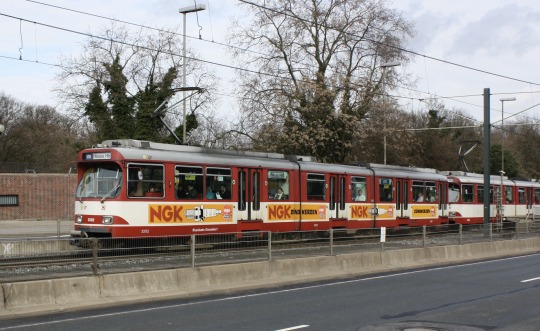
In fact, there was even a dual headlight version for Vienna, but specifically only for the Wiener Lokalbahnen, a sort of interurban railway that used streetcar tracks at the Vienna end of its route. This seems to have been a common division of headlights: Single for the purely city routes, double for the longer-distance ones, until everyone standardised on double, eventually with the third headlight on top.
For added confusion, some cities, most notably Stuttgart and Hanover, used double headlights stacked on top of each other. I assume that's meant to count as one headlight, just doubled up in case one burns out.
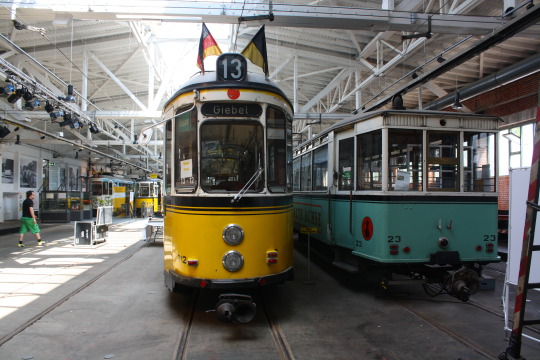
A very rare specialty: Two headlights side by side but mounted centrally, seen in Frankfurt am Main and I don't think a lot of other places. It's not relevant, I just want to show it because it looks so silly.
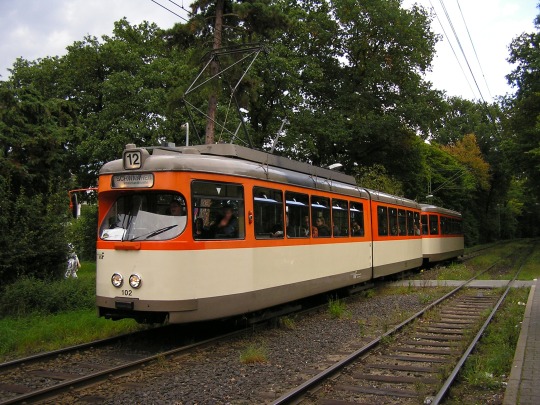
Picture: TdVG Harthweg M+m.jpg, © MdE on Wikimedia Commons and Wikipedia-DE, License: CC-BY-SA 3.0 DE
Next, turn indicators. All trams have turn indicators on their sides, generally at window level, but within the window level it's anyone's guess. Some place them near the roof, some more near the middle or bottom of the windows, it seems to be whatever the operator prefers. Turn indicators at the front, near the headlights, are surprisingly not that common. Most single-headlight trams don't have them, the turn indicators on the side have to be enough.
However, the turn indicators are often found at the rear of the train, and that also puts them on the front of dual-direction vehicles (which many trams aren't). See this Frankfurt trailing car, which can only run at the end of the train:
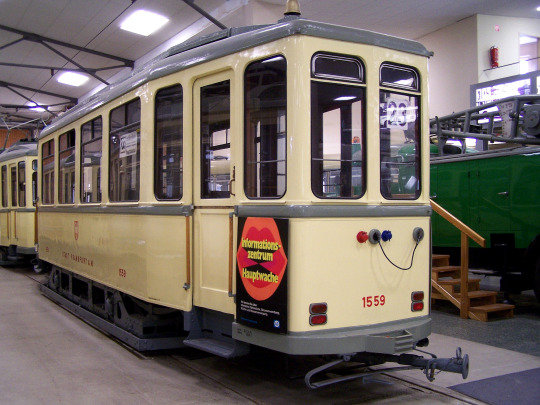
Picture: H-Beiwagen Schwanheim 01052009.JPG, © Urmelbeauftragter on Wikimedia Commons and Wikipedia-DE, License: CC-BY-SA 3.0 unported
You see two red tail lights, and two orange blinker lights. And, in fact, on a dual-direction train from Frankfurt, you'll see the same lights on the front:

Picture: Peter Stehlik 2012.02.18 015a.jpg, © Peter Stehlik on Wikimedia Commons and Wikipedia-DE, License: CC-BY-SA 3.0 unported
But this wasn't always the case. Consider the SSB B2 trailing car from Stuttgart. It has neither motor nor cab, and must always appear at the end of a train. Despite this, it has a (single) headlight for some reason. Perhaps for when the train needs to back up? Below it is a single red tail light. The two other red things near the coupler are just reflectors.
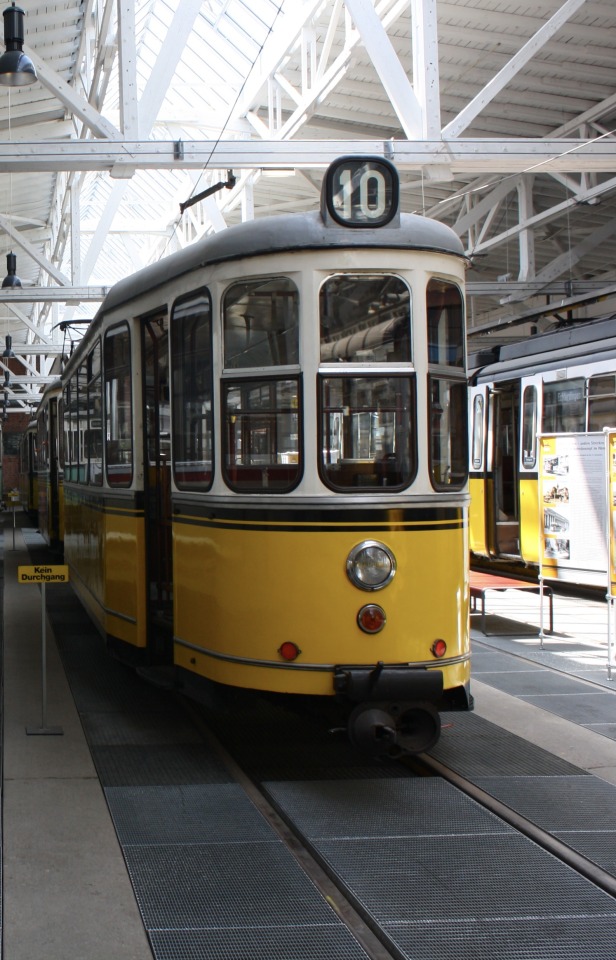
Actually, is that a red tail light? I took that picture in 2013, so it's been a while, and it looks pretty orange, both here and in some historic pictures, e.g. this one from 1979:
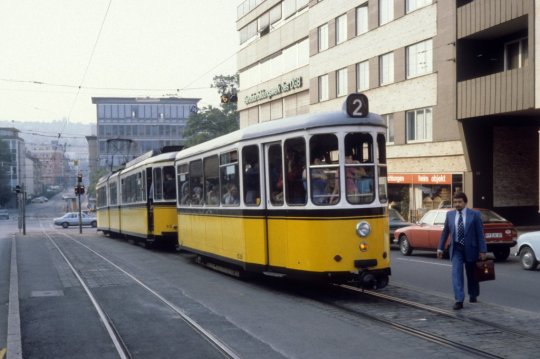
Picture: Stuttgart-ssb-sl-2-bw-654287.jpg, © Kurt Rasmussen from bahnbilder.de, found on Wikipedia, licensed for any use as long as the author is credited
Colors on old photographs are a bit of a crap shoot, and in newer videos the B2s definitely have red tail lights, like here:
youtube
But in that video it also doesn't have a headlight, so who knows what rebuilds that one in the video has been through.
Of course, if it's a single orange light, that raises the question: What's that for? Orange tail lights? As far as I can tell, probably not. In fact, a combination that is surprisingly not that uncommon is a single red and a single orange tail light, e.g. here on a historic tram in Nuremberg.
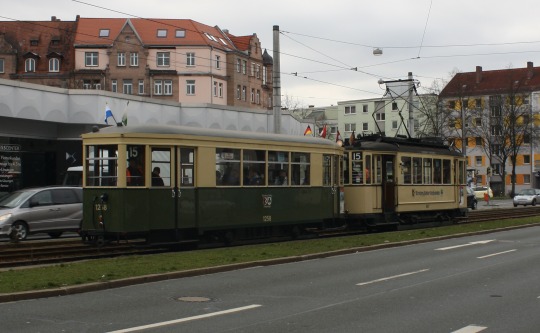
That yellow/orange light is not the "backwards turn indicator". It's the brake light.
Yes, orange brake lights used to be a thing in Germany. For cars, they were phased out in the 1960s. I think historic cars are still allowed to have them, if you can find one. For streetcars, they were phased out a bit later.
Specifically, 2016.
Until then it was legal and very common to have yellow brake lights on trams, even some very modern ones. These are usually combined with the rear turn indicators: If they both light up steadily, the tram is braking, if they're blinking, the tram is about to turn. According to Wikipedia, if it's braking and turning, then one light will light steadily, the other will be blinking, similar to those red turn signals some cars in the US use.
Note, however, that "make the red tail light brighter" (or "turn it on") seems to have been absolutely legal as well, just not super popular. This video from 1974, the final year of the streetcar system in Aachen shows both types of brake lights in action:
youtube
At this point the streetcar network in that city was in terminal decline, and all the cars there were either second-hand or cheaply rebuilt 1950s stuff, so it makes sense that the lighting system was all over the place.
Final note because it didn't fit anywhere else: A single giant tail light, at least on trailer cars, doesn't seem to have ever been used in Germany, but it was not uncommon in Austria.
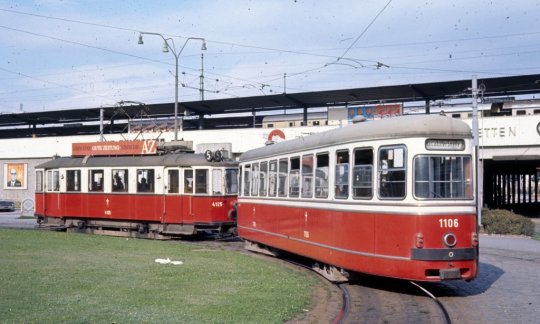
Picture: Wien-wvb-sl-5-c2-567109.jpg, © Kurt Rasmussen from bahnbilder.de, found on Wikipedia, licensed for any use as long as the author is credited
Other note: It seems that side turn indicators on trailer cars were optional at times. Weird.
So why do you need to know all of that? You don't. I never said you did. I did, however, because I'm currently modifying some trams for my model railroad with better lighting functions, and I wanted to know what the end result should be. The answer is, apparently, "do whatever you want", which is frankly very liberating.
I want to make it clear that this is not an expert or well researched piece. These are just the notes I made in my head while I was trying to figure this out. I almost certainly got things wrong, and I definitely missed some nuances. If you happen to know any, or can give more information on what it was like in your country, or you just feel like it, any comment/reblog with notes/anon hate is absolutely appreciated.
All pictures where no source is mentioned are © me. Use them under CC-BY-SA 3.0 if you want.
8 notes
·
View notes
Text
Operation: Time Twister - Case 1: Compiled Control
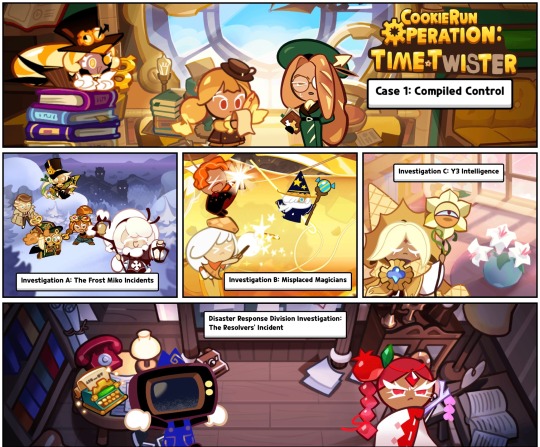
🥖 Briefing: Support Division, this is your first major case as part of “Operation: Time Twister” and definitely not the last. Unlike the Orientation, which had a set narrative from beginning to end as it was in the past prior to the formation of this task force, you will have your chance to influence the story between posted Files. Likewise, this story will be a lot more complicated as turbulence from other temporal regions beyond Earthbread is to be expected. However, if collateral damage occurs, you will be held accountable for any expenses. Here are the immediate missions that are part of this Case:
Locate Croissant Cookie’s group consisting of her, Walnut Cookie, Almond Cookie, and Roguefort Cookie within the Past Dark Cacao Kingdom and return everyone back to their proper times
Track down the locations of Cinnamon Cookie, Wizard Cookie, and Cream Puff Cookie to return them to [12/24/2020 - PET-EB-C/W] safely
Retrieve loose fragments of the Blue Cheese Watch where possible
Follow up on newfound evidence regarding White Lily Cookie, Beast-Yeast, Lilywhite Space, and the Lilywhite Capital
Locate and retrieve any of White Lily Cookie’s Soulstones if possible
——————————————————————————————
🍓🍰 Disaster Response Division Memo: A new time rift has torn open in a far-eastern region of Outer Earthbread within the Primary Earthbread Timeline. Detected temporal signatures suggest that this rift was caused by loose parts of the Blue Cheese Watch, although more evidence is needed. Intelligence reports suggest that at least three people have fallen into this rift. Be on the lookout for these people who may not appear as Cookies and more likely to look like the Witch. We will be sending Strawberry Shortcake Cookie, the High Priestess of the Pomegranate Village, and a staff member of the railway transportation services of the World of Dreams to lead the detachment’s investigations, the latter of whom were commissioned as support. As such, here are the additional missions posed by the Disaster Response Division for your team:
Assist in the gathering of testimonies from local townspeople from the region
Identify any and all immediately misplaced individuals from this region
Locate misplaced individuals that have been sent to Earthbread after entering the time rift
Return all misplaced individuals to their respective region
Create a comprehensive report on how the time rift opened in the region
Stabilize the time rift before it causes additional damage within the region
Record all individuals involved on the Subject Roster
——————————————————————————————
Case Investigations
Investigation A: The Frost Miko Incidents (Active)
Investigation B: Misplaced Magicians
Investigation C: Y3 Intelligence
Ongoing Side Investigation: The Resolvers’ Incident - Courtesy of the Disaster Response Division. Their investigation’s progress will be listed within the individual investigations.
———————————————————————————————
Supervisory Memos
Timeguard Keepers are on standby for dispatch, and we plan to send three of them. Suggest via the ask box a parallel presence of someone whom you want to see from the canon lineup as a Keeper. Selections will happen behind the scenes regardless.
Support has been requested from forward field agents. It is now up to you to service these requests at your discretion. You as the Support Division can now partially influence the story by sending asks between Case Files according to incoming requests.
The pinned post has been updated to organize AU terminology and tags and to add a few more.
The Subject Roster, Space-Time Atlas, and Inquiry Master List are under development. Remaining Subject Records that have not been processed and made available to you during the Orientation will be processed after the publication of the Subject Roster.
Subject Roster - Under Development
Space-Time Atlas - Under Development
Inquiry Master List - Under Development
#cookie run au#operation: time twister#cookie run#case 1#tbd case record#croissant cookie#roguefort cookie#walnut cookie#almond cookie#cinnamon cookie#wizard cookie#cream puff cookie
11 notes
·
View notes
Text
Railway Service Resumes After Howrah-Mumbai Mail Accident
Track Repairs Completed, Operations Gradually Returning to Normal Rail operations resume post Howrah-Mumbai Mail accident near Potobeda. Damaged tracks repaired, undergoing safety tests. Trains initially running at reduced speeds for precautionary measures. JAMSHEDPUR – Railway authorities have successfully repaired the damaged tracks following the Howrah-Mumbai Mail train accident near Potobeda…
#जनजीवन#Chakradharpur Railway Division repairs#Howrah-Mumbai Mail accident#Indian Railways maintenance#Jharkhand train services#Life#post-accident railway operations#Potobeda village train derailment#railway infrastructure recovery#railway track restoration#Saraikela-Kharsawan railway updates#train safety measures
0 notes
Text
Chai garam, chai garam, chai garam!
The Indian Railways system, established in 1853, is one of the largest and oldest railway networks in the world. Since its inception, it has played a critical role in connecting distant regions of the country, supporting both passenger and freight transportation. Initially built and operated by private companies under British colonial rule, the railways were later nationalized in 1951, bringing the entire network under the control of the Government of India. This shift was made to ensure the efficient expansion of rail infrastructure, uniformity in service delivery, and better integration of the system across the subcontinent. Since nationalization, Indian Railways has operated as a government monopoly, with centralized control and management through the Ministry of Railways and the Railway Board. This structure has allowed the government to prioritize public welfare, providing affordable transportation while facilitating economic development.
The centralized control system of Indian Railways enables uniform decision-making, centralized resource allocation, and coordinated operations across its various zones and divisions. All key decisions, from scheduling to budgeting, infrastructure development, and safety protocols, are managed by the central government. This structure ensures a standard level of service across the country, with the Railway Board responsible for policy formulation, regulatory compliance, and financial management. While this centralized system has ensured operational consistency and widespread accessibility, it has also led to challenges such as inefficiency, delays in modernization, and financial strains, given the vast scale of operations. These limitations have been a driving force behind discussions on potential privatization and decentralization, aiming to improve efficiency and foster competition within the sector.
Task at Hand: This centralized structure has ensured operational consistency but has also led to inefficiencies, delays, and limited innovation. Due to this reason, the Indian Government has decided to open the railways market and privatize the sector. With the privatization of the railway sector, there is now an opportunity for private companies to enter the market, creating competition that will hopefully drive better services, financial performance, and customer satisfaction. You are tasked with building a comprehensive plan for your railway company, addressing crucial aspects such as system design, financials, and marketing.
Deliverables:
1. Railway system design (network coverage, infrastructure, technology integration)
2. Initiation costs and financial projections (startup costs, revenue streams, expenses,
funding strategy)
3. Unique Selling Proposition (USP) and value proposition
4. Marketing strategies (target market analysis, branding, promotional tactics, pricing
strategy)
5. Operational plan (applying for government tenders, service offerings, scheduling, staffing)
6. Extra deliverables are welcome.
2 notes
·
View notes
Text

NWR Roster Headcanons: Thomas the Tank Engine
–
Alright, headcanon time. According to Wilbert Awdry, there are a total of 80 engines on the NWR network. But I decided to increase that number because why not? Quick disclaimer, the engine numbers are not necessarily reflective of the order in which they arrived. Anyway, this is going to start off a series of posts covering the engine roster. So first up is none other than the cheeky Number 1 himself, Thomas the Tank Engine.
–
Although Awdry never stated which E2 he is, early NWR records confirm his build date as June 1915. Shortly after being built, Thomas was requisitioned by the Railway Operating Division and sent off to Sodor to help finish construction of the North Western Railway.
–
When the Great War ended, it was originally planned to return him to the LBSC, but Brighton Works had already built a replacement 105 and thus sold Thomas to the NWR in 1920.
–
Despite having mellowed out somewhat since the early days, he still remains a fussy sort of engine. But Thomas is very proud of his branch line, and won’t let you forget that it’s the most important part of the railway.
–
And now for some Thomas trivia
–
Except for early in his life, during the 1940s, and the 2014 Centenary celebrations, Thomas has always been NWR Blue.
–
Despite having a well-known tendency to be jealous of other tank engines, there was one instance in 1985 when a tank engine was jealous of him. Thomas has little to say about this experience, but remains baffled by it to this very day.
–
In addition to Annie and Clarabel, Thomas also has a third coach. Her name is Margot, and she’s best known for being the coach involved in the Missing Coach incident, much to her indignation.
–
Lastly, the Ffarquhar Branch Line definitely wasn’t proposed for closure in 1962 and Thomas definitely didn’t proceed to call Beeching several things that can’t be repeated.
–
Originally, I planned to include something about Thomas’ reaction to All Engines Go. But it didn’t really fit in my opinion, so I ultimately decided not to include it. Anyway, I’ll probably get Edward’s post out in the next couple days, so look forward to it.
5 notes
·
View notes
Text
Chemical Manufacturing Companies in Houston

The Role of Chemical Manufacturing Companies in Houston
Introduction
Houston, Texas, is a powerhouse in the world of energy and industrial production, with a particularly strong reputation in the chemical manufacturing sector. The city is often referred to as the "Energy Capital of the World," but it’s also a critical hub for chemical production, contributing significantly to the global supply chain. Chemical manufacturing companies in Houston are at the forefront of innovation, producing a wide range of chemicals that are essential for numerous industries, from healthcare and agriculture to electronics and automotive manufacturing. This article delves into the importance of these companies, the range of products they create, and their impact on both the local and global economy.
The Significance of Houston’s Chemical Manufacturing Industry
Houston’s strategic location near the Gulf of Mexico, coupled with its extensive infrastructure, makes it an ideal location for chemical manufacturing. The city is home to the largest petrochemical complex in the United States, and this has fostered a robust ecosystem of chemical manufacturing companies. These companies benefit from the proximity to raw materials, such as oil and natural gas, which are essential inputs for chemical production. Additionally, the city’s well-established logistics network, including ports, railways, and highways, facilitates the efficient distribution of chemical products both domestically and internationally.
The chemical manufacturing industry in Houston is not only a major contributor to the local economy but also plays a critical role in supporting other industries. The chemicals produced in Houston are used in the production of plastics, pharmaceuticals, fertilizers, and countless other products that are integral to modern life. Without the chemicals manufactured in Houston, many industries would struggle to maintain their current levels of production and innovation.
Key Players in Houston's Chemical Manufacturing Sector
Several major companies dominate the chemical manufacturing landscape in Houston, each contributing to the industry’s strength and diversity. These companies range from multinational corporations to specialized firms that focus on niche markets.
Dow Chemical Company: One of the largest chemical manufacturers in the world, Dow has a significant presence in Houston. The company produces a vast array of chemicals, including plastics, performance materials, and agricultural products. Dow’s Houston operations are integral to its global supply chain, enabling the company to meet the demands of industries across the globe.
ExxonMobil Chemical: As a division of one of the largest oil companies in the world, ExxonMobil Chemical plays a crucial role in the production of petrochemicals. The company’s Houston facilities produce a wide range of products, including polyethylene, polypropylene, and other polymers that are used in packaging, automotive components, and consumer goods. ExxonMobil Chemical’s innovations in polymer technology have helped drive advancements in material science, contributing to the development of lighter, stronger, and more sustainable products.
LyondellBasell: This company is one of the largest plastics, chemicals, and refining companies in the world. With its headquarters in Houston, LyondellBasell is a key player in the production of polypropylene, polyethylene, and advanced polymers. The company’s products are used in a variety of applications, from packaging and textiles to automotive parts and medical devices. LyondellBasell is also a leader in sustainability, with initiatives aimed at reducing plastic waste and promoting circular economy practices.
BASF Corporation: A subsidiary of the German chemical giant BASF SE, BASF Corporation operates several facilities in the Houston area. The company produces a wide range of chemicals, including those used in agriculture, automotive, and construction industries. BASF is known for its commitment to innovation, investing heavily in research and development to create new and improved chemical products that meet the evolving needs of its customers.
The Impact of Chemical Manufacturing on the Local Economy
The chemical manufacturing industry is a major driver of economic activity in Houston. The sector provides thousands of high-paying jobs, ranging from engineers and chemists to skilled laborers and logistics professionals. These jobs not only support the livelihoods of those directly employed by chemical manufacturing companies but also create a ripple effect throughout the local economy. For example, the presence of a strong chemical manufacturing sector attracts other businesses, such as suppliers, contractors, and service providers, further boosting economic growth in the region.
In addition to job creation, chemical manufacturing companies in Houston contribute significantly to the city’s tax base. The revenue generated from these taxes helps fund essential public services, such as education, healthcare, and infrastructure development. Furthermore, the industry’s emphasis on innovation and sustainability has led to the development of new technologies and processes that have the potential to reduce environmental impact and improve efficiency across various sectors.
Environmental and Safety Considerations
While the chemical manufacturing industry in Houston is vital to the economy, it also presents challenges, particularly in terms of environmental impact and safety. The production of chemicals involves the use of hazardous materials, and if not properly managed, these materials can pose risks to both human health and the environment.
To address these concerns, chemical manufacturing companies in Houston are subject to stringent regulations enforced by federal and state agencies, such as the Environmental Protection Agency (EPA) and the Texas Commission on Environmental Quality (TCEQ). These regulations govern everything from emissions and waste disposal to workplace safety standards. Companies are required to implement comprehensive safety and environmental management systems to minimize risks and ensure compliance with these regulations.
Many chemical manufacturers in Houston have gone beyond regulatory requirements, adopting best practices in sustainability and safety. For instance, companies like LyondellBasell and BASF have implemented programs to reduce greenhouse gas emissions, minimize waste, and promote the use of renewable energy sources. These initiatives not only help protect the environment but also enhance the companies’ reputations and appeal to customers who prioritize sustainability.
The Future of Chemical Manufacturing in Houston
The chemical manufacturing industry in Houston is poised for continued growth, driven by advancements in technology, increasing demand for chemicals, and the city’s strategic advantages. However, the industry will also need to navigate challenges related to environmental sustainability, regulatory compliance, and global competition.
One of the key trends shaping the future of chemical manufacturing in Houston is the shift towards sustainability. As consumers and businesses become more environmentally conscious, there is increasing pressure on chemical manufacturers to reduce their carbon footprints and adopt more sustainable practices. This shift is likely to drive innovation in areas such as green chemistry, renewable feedstocks, and circular economy models.
Another important trend is the growing role of digitalization in chemical manufacturing. Companies are increasingly using digital technologies, such as data analytics, artificial intelligence, and automation, to improve efficiency, optimize production processes, and enhance safety. These technologies have the potential to transform the industry, enabling companies to operate more sustainably and respond more quickly to changing market demands.
Conclusion
Chemical manufacturing companies in Houston play a critical role in the global supply chain, producing essential chemicals that support a wide range of industries. The city’s strategic location, robust infrastructure, and access to raw materials make it an ideal hub for chemical production. As the industry continues to evolve, driven by trends in sustainability and digitalization, Houston’s chemical manufacturers will be at the forefront of innovation, contributing to economic growth and helping to address some of the world’s most pressing challenges.
In conclusion, the chemical manufacturing industry in Houston is a vital part of the city’s economy and a key player on the global stage. By continuing to prioritize innovation, sustainability, and safety, these companies will not only maintain their competitive edge but also contribute to a more sustainable and prosperous future for all.
2 notes
·
View notes